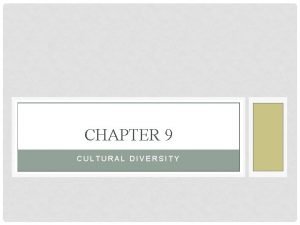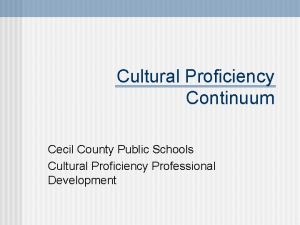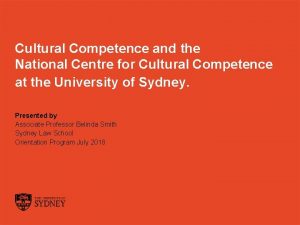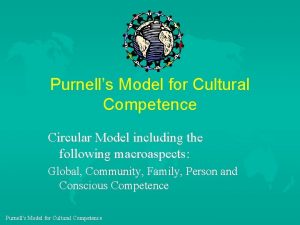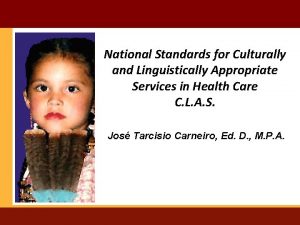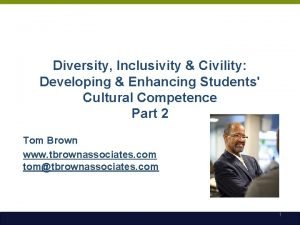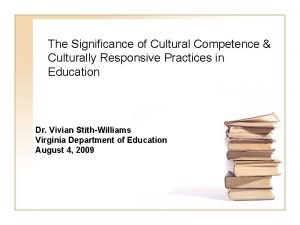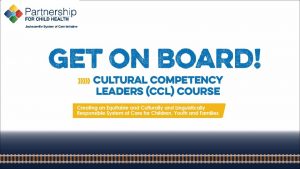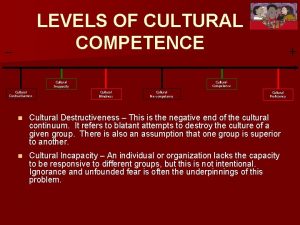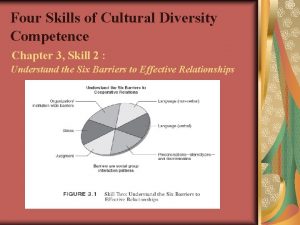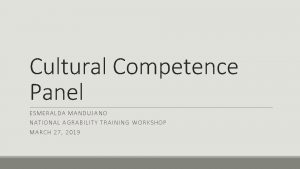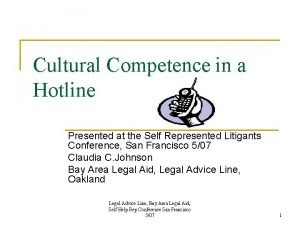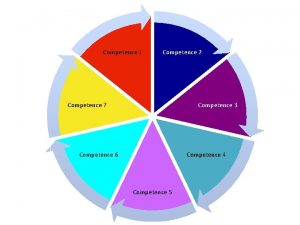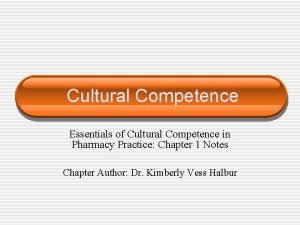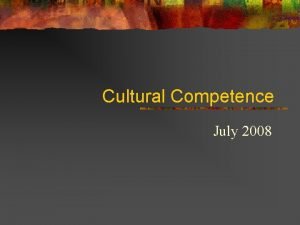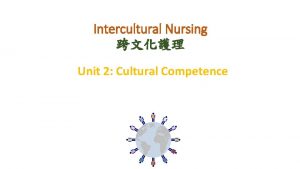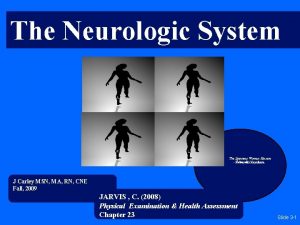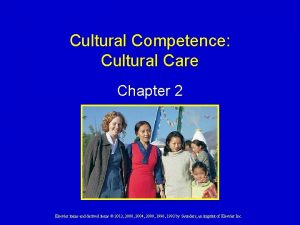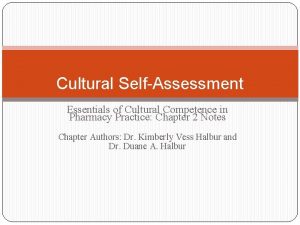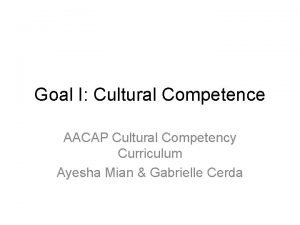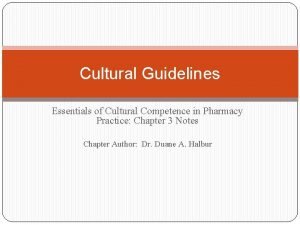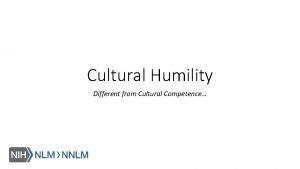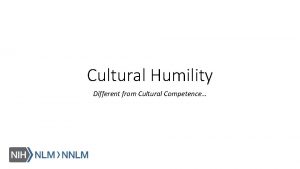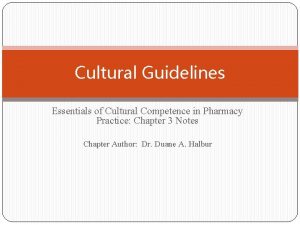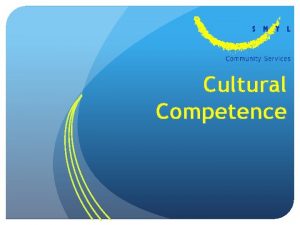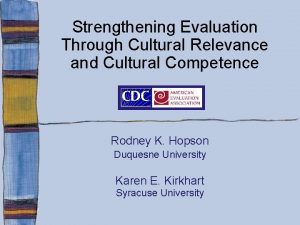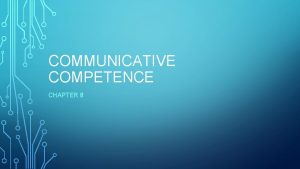Chapter 2 Cultural Competence Why is Cultural Competence



























- Slides: 27

Chapter 2 Cultural Competence

Why is Cultural Competence Important? • US is culturally diverse, lending to significant challenges in meeting health care needs • Different groups may have a difficult time entering and interacting with the health care system in the US. • Illegal immigrants, naturalized citizens, the poor • • Language may be a barrier • There are Laws in place to insure culturally competent and sensitive treatment of people Health beliefs and practices may be different and health care providers need to understand acknowledge these.

National Cultural and Linguistic Standards • First and landmark standard • Health care organizations should ensure that patients receive from all staff members effective, understandable, and respectful care that is provided in a manner compatible with their cultural health beliefs and practices and preferred language* *Source: National Standards for Culturally and Linguistically Appropriate Services in Health Care, Final Report, March 2001, Washington, DC: Office of Minority Health, DHHS

National Cultural and Linguistic Standard Components • Effective care: positive outcomes and satisfaction for patient • Respectful care: considers values, preferences, and expressed needs of patient • Cultural and linguistic competence: congruent behaviors, attitudes, and policies that come together in a system among professionals that enables work in cross-cultural situations

Linguistic Competence • Title VI of Civil Rights Act of 1964 • Services cannot be denied to people of limited English proficiency • In 2012, over 21% of Americans over 5 years of age speak a language other than English in their homes • Most common non-English language is Spanish • Patients who have limited English proficiency (LEP) are at risk for poor health care outcomes due to the barrier that language presents during health care delivery interactions • Health care facilities may have established interpreters who can assist with therapeutic communication.

Cultural Competence • Culturally sensitive • Possessing basic knowledge of and constructive attitudes toward diverse cultural populations • Culturally appropriate • Applying underlying background knowledge necessary to provide the best possible health care • Culturally competent • Understanding and attending to total context of patient’s situation including the following: • • • Immigration status Stress and social factors Cultural similarities and differences

Cultural Competency Questions • Who are you meeting for the first time? • Where does the patient come from? • What is his or heritage? • What is his or her cultural background: ethnicity and religion? • Does the patient understand, speak, and read English? • What language does he or she understand, speak, and read? • What are his or health and illness beliefs and practices?

Steps to Cultural Competence • Understand one’s own heritage-based values, beliefs, attitudes, and practices • Identify meaning of “health” to patient • Understand how health care system works • Acquire knowledge about social backgrounds of patients • Become familiar with languages, interpretive services, and community resources available to nurses and patients

Related Concepts: Culture • Thoughts, communications, actions, beliefs, values, and institutions of racial, ethnic, religious, or social groups • Characteristics of culture • • Learned Shared Adapted Dynamic

Related Concepts: Ethnicity • Describes a group united by the following: • • Common geographic origin Migratory status Religion Race Language Shared values, traditions, or symbols Food preferences

Related Concepts: Religion • Belief in divine or superhuman power, or powers to be obeyed and worshipped as creator/ruler of universe • System of beliefs, practices, and ethical values • Shared experience of spirituality

Socialization • Process of being raised within a culture and acquiring characteristics of that group • Related terms: • Acculturation: process of adapting to and acquiring another culture • Assimilation: process of developing a new cultural identity and becoming like members of dominant culture • Biculturalism: dual pattern of identification and often of divided loyalty

Health-Related Beliefs and Practices • Balance and beliefs about causes of illness • Biomedical or scientific theory • Naturalistic or holistic theory • • Yin and yang Hot and cold • Magicoreligious perspective • Traditional beliefs and health healers

Disease Causation Theories • • Biomedical • • Assumes cause and effect Views the body as a machine Life can be divided into parts Endorses germ theory Naturalistic • • Forces of nature must be kept in balance Embraces idea of opposing categories or forces • Yin and yang, hot and cold

Disease Causation Theories (Cont. ) • Magicoreligious • Supernatural powers predominate in area of health and illness • Examples include voodoo, witchcraft, and faith healing • Healing and culture • In addition to seeking help from health care providers, patients may also seek help from folk or religious healers • Hispanics or American Indians may believe that cure is incomplete unless healing is carried out for the body, mind, and spirit

Health-Related Behaviors Affected by Religion • • • Meditating • • Pilgrimage Exercising/physical fitness Sleep habits Vaccinations Willingness to undergo physical examination Truthfulness about how patient feels • • • Maintenance of family viability Hoping for recovery Coping with stress Genetic screening and counseling Living with a disability Caring for children

Differing Views Related to Health Beliefs • Differing views of epilepsy • • Uganda: contagious, untreatable Greece: source of family shame Mexican-American community: evidence of physical imbalance Hutterites: evidence of having endured trial by God

Traditional Folk Healers • Hispanic: curandero, espiritualista, yerbo, or sabedor • Black: hougan, spiritualist, old lady • American Indian: shaman, medicine woman, medicine man • Asian: herbalists, acupuncturists, bone setters • Amish: braucher

Developmental Competence • Culture affects choices parents make for children regarding the following: • • • Presumed cause of illness First treatment tried Acceptability of treatments offered by clinicians • For older patients, culture is likely to do the following: • • Define their family responsibilities Affect their view and knowledge of health care systems used by dominant culture

Transcultural Expression of Illness • Transcultural expression of pain • Expectations, manifestations, and management of pain are all embedded in a cultural context • Pain has been found to be a highly personal experience, depending on cultural learning, the meaning of the situation, and other factors unique to the person • Silent suffering has been identified as the most valued response to pain by health care professionals

Culture-Bound Syndromes • Condition that is culturally defined • • Some have no equivalent in a biomedical, scientific perspective Anorexia nervosa and bulimia are examples of cultural aspects of illness in dominant cultural population in North America

Heritage Consistency Concepts • Heritage consistency • Degree to which a person’s lifestyle reflects his or her traditional heritage • Heritage consistency continuum • • Traditional: living within norms of traditional culture Modern: acculturated to norms of dominant society

Indicators of Heritage Consistency • Childhood occurred in country of origin or immigrant neighborhood of like ethnic group • • • Extended family support of traditional activities Frequent visits to old country or old neighborhood Family home within ethnic community to which they belong Participation in ethnic cultural events Raised in extended family setting

Indicators of Heritage Consistency (Cont. ) • • • Regular contact with extended family Name not anglicized Educated in parochial school Social activities primarily with members of ethnic community Knowledge of language and culture of origin Expresses pride in heritage

Culture and Treatment • First effort at treatment is often self-care • Home treatment attractive for accessibility, particularly for people from rural or sparsely populated areas • Home treatment may mobilize person’s social support network and provide a caring environment in which to convalesce • Alternative or complementary interventions are gaining recognition from health care professionals in health care system

Culture and Disease Prevalence • Disparity continues in deaths and illnesses experienced by racial and ethnic populations • Diseases are not distributed equally among all segments of population • Abnormal biocultural variations may be genetic or acquired • Information about disease prevalence for racial and ethnic groups provides focus for assessment regarding increased probability that particular conditions may occur • Nurses must be certain that they have gathered data needed to support or refute suspicions

Culture and Respect • Realize you must know heritage of yourself and patient • Examine patient within cultural context • Select simple questions and speak slowly • Pace questioning throughout exam • Encourage patient to discuss meaning of health and illness with you • Check patient’s understanding and acceptance of recommendations • Touch patient within boundaries of his or heritage
 Why why why why
Why why why why Chapter 9 cultural diversity
Chapter 9 cultural diversity What is cultural incapacity
What is cultural incapacity Cultural competence examples
Cultural competence examples National centre for cultural competence
National centre for cultural competence Purnell's model for cultural competence
Purnell's model for cultural competence Perbedaan competence dan competency
Perbedaan competence dan competency Naeyc pathways to cultural competence checklist
Naeyc pathways to cultural competence checklist Staircase that represents cultural competence
Staircase that represents cultural competence Understanding civility and cultural competence
Understanding civility and cultural competence Cultural competence on resume
Cultural competence on resume Cultural competence
Cultural competence Terry cross cultural competence
Terry cross cultural competence Levels of cultural competence
Levels of cultural competence Nea cultural competence
Nea cultural competence Four skills of cultural diversity competence
Four skills of cultural diversity competence Cultural competence
Cultural competence Cultural competence
Cultural competence Dont ask
Dont ask Why-why analysis
Why-why analysis Wh tongue twisters
Wh tongue twisters Does this table represent a function why or why not
Does this table represent a function why or why not What does a table represent
What does a table represent Why or why not
Why or why not Contoh root cause analysis 5 why
Contoh root cause analysis 5 why Tadeusz snuk
Tadeusz snuk La compétence définition
La compétence définition Grammatical competence
Grammatical competence

